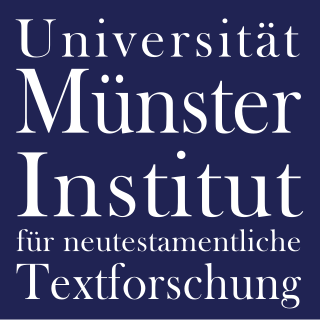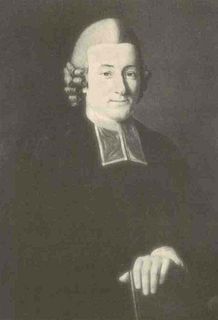History
Gregory dated the manuscript to the 11th century. [3] It has been assigned by the Institute for New Testament Textual Research (INTF) to the 9th or 10th century. [1] [2]

The Institute for New Testament Textual Research at the University of Münster, Westphalia, Germany, is to research the textual history of the New Testament and to reconstruct its Greek initial text on the basis of the entire manuscript tradition, the early translations and patristic citations; furthermore the preparation of an Editio Critica Maior based on the entire tradition of the New Testament in Greek manuscripts, early versions and New Testament quotations in ancient Christian literature. Under Kurt Aland's supervision, the INTF collected almost the entire material that was needed - Manuscript count 1950: 4250; 1983: 5460; 2017: approx. 5800.
The manuscript was examined by Johann Jakob Griesbach and Scholz. [3]

Johann Jakob Griesbach, German biblical textual critic, was born at Butzbach, a small town in the state of Hesse-Darmstadt, where his father, Konrad Kaspar (1705–1777), was pastor. Griesbach's fame rests upon his work in New Testament criticism, in which he inaugurated a new epoch. His solution to the synoptic problem bears his name, but the Griesbach hypothesis has been modernly referred to as the Two-Gospel hypothesis.

Johann Martin Augustin Scholz was a German Roman Catholic orientalist, biblical scholar and academic theologian. He was a professor at the University of Bonn and travelled extensively throughout Europe and the Near East in order to locate manuscripts of the New Testament.
The manuscript was added to the list of New Testament manuscripts by Johann Jakob Wettstein (number 98e). Gregory catalogued it as number 294e. Gregory saw the manuscript in 1891. [3]
Johann Jakob Wettstein was a Protestant Swiss theologian, best known as a New Testament critic.

Caspar René Gregory was an American-born German theologian.
The manuscript is not cited in the critical editions of the Greek New Testament (UBS3). [4]
The codex is housed at the University of Tübingen (Mb. 4), in Tübingen. [1] [2]
This page is based on this
Wikipedia article Text is available under the
CC BY-SA 4.0 license; additional terms may apply.
Images, videos and audio are available under their respective licenses.
Lectionary 15, designated by siglum ℓ 15. It is a Greek manuscript of the New Testament, on vellum leaves. Palaeographically it has been assigned to the 13th-century.
Lectionary 283, designated by siglum ℓ 283 is a Greek manuscript of the New Testament, on parchment. Palaeographically it has been assigned to the 11th century.
Scrivener labelled it as 162e.
Lectionary 280, designated by siglum ℓ 280 is a Greek manuscript of the New Testament, on parchment. Palaeographically it has been assigned to the 14th century.
Scrivener labelled it as 185e.
Lectionary 284, designated by siglum ℓ 284 is a Greek manuscript of the New Testament, on parchment. Palaeographically it has been assigned to the 10th century.
Scrivener labelled it as 163e.
Lectionary 285, designated by siglum ℓ 285 is a Greek manuscript of the New Testament, on parchment. Palaeographically it has been assigned to the 12th century.
Frederick Henry Ambrose Scrivener labelled it as 164e and 165e.
Lectionary 286, designated by siglum ℓ 286 is a Greek manuscript of the New Testament, on parchment. Palaeographically it has been assigned to the 9th century.
Scrivener labelled it as 480e.
Lectionary 287, designated by siglum ℓ 287 is a Greek manuscript of the New Testament, on parchment. Palaeographically it has been assigned to the 13th century.
Frederick Henry Ambrose Scrivener labelled it as 166e.
Lectionary 288, designated by siglum ℓ 288 is a Greek manuscript of the New Testament, on parchment. Palaeographically it has been assigned to the 13th century.
Scrivener labelled it as 167e.
Lectionary 289, designated by siglum ℓ 289 is a Greek manuscript of the New Testament, on parchment. Palaeographically it has been assigned to the 14th century.
Frederick Henry Ambrose Scrivener labelled it as 168e.
Lectionary 291, designated by siglum ℓ 291 is a Greek manuscript of the New Testament, on parchment. Palaeographically it has been assigned to the 11th century.
Scrivener labelled it as 187e.
Codex Tischendorfianus V or Lectionary 293 (Gregory-Aland), designated by siglum ℓ 293 is a Greek manuscript of the New Testament, on parchment. Palaeographically it has been assigned to the 8th century.
Scrivener labelled it as 190e.
Lectionary 295 (Gregory-Aland), designated by siglum ℓ 295 is a Greek manuscript of the New Testament, on parchment. Palaeographically it has been assigned to the 9th or 10th century.
Lectionary 301 (Gregory-Aland), designated by siglum ℓ 301 is a Greek manuscript of the New Testament, on parchment. Palaeographically it has been assigned to the 13th century. The manuscript is lacunose.
Lectionary 305 (Gregory-Aland), designated by siglum ℓ 305 is a Greek manuscript of the New Testament, on parchment. Palaeographically it has been assigned to the 12th century. The manuscript is lacunose.
Lectionary 306 (Gregory-Aland), designated by siglum ℓ 306 is a Greek manuscript of the New Testament, on parchment. Palaeographically it has been assigned to the 13th century. The manuscript is lacunose.
Lectionary 308 (Gregory-Aland), designated by siglum ℓ 308 is a Greek manuscript of the New Testament, on parchment. Palaeographically it has been assigned to the 11th century. The manuscript is lacunose.
Lectionary 309 (Gregory-Aland), designated by siglum ℓ 309 is a Greek manuscript of the New Testament, on parchment. Palaeographically it has been assigned to the 10th century. The manuscript is lacunose.
Lectionary 330 (Gregory-Aland), designated by siglum ℓ 330 is a Greek manuscript of the New Testament, on parchment. Palaeographically it has been assigned to the 12th century. The manuscript has not survived in complete condition.

Lectionary 313 (Gregory-Aland), designated by siglum ℓ 313 is a Greek manuscript of the New Testament, on parchment. Palaeographically it has been assigned to the 14th-century. The manuscript has survived in a fragmentary condition.
Lectionary 335 (Gregory-Aland), designated by siglum ℓ 335 is a Greek manuscript of the New Testament, on parchment. Palaeographically it has been assigned to the 11th-century. The manuscript has survived in complete condition.








